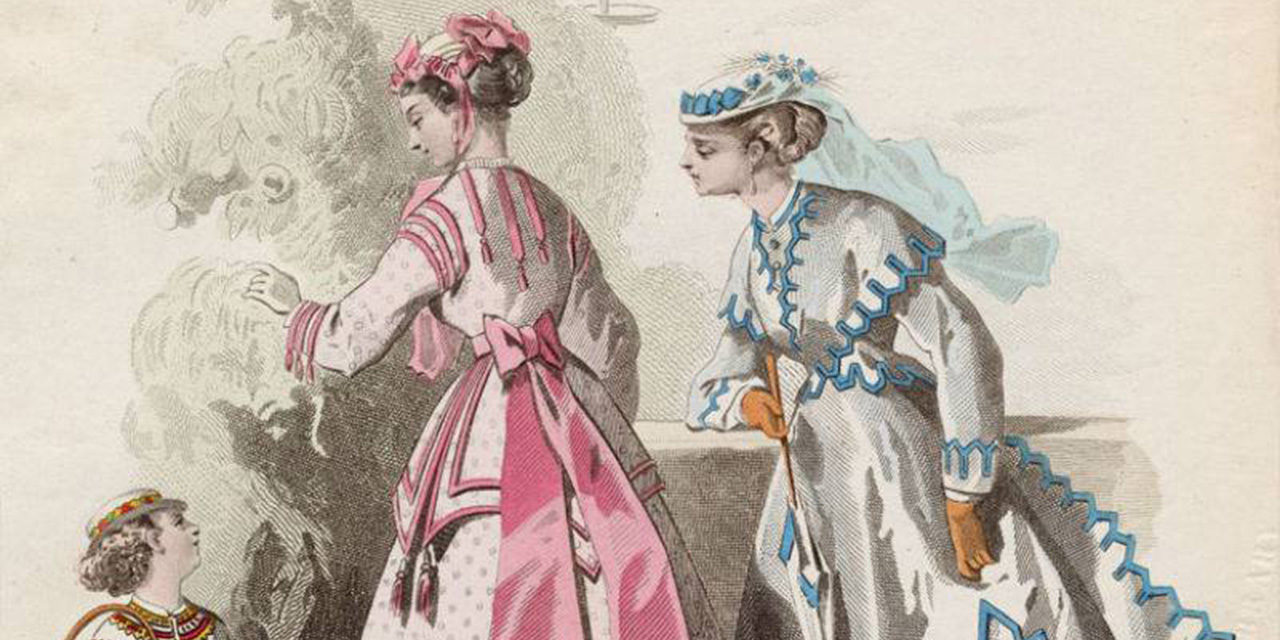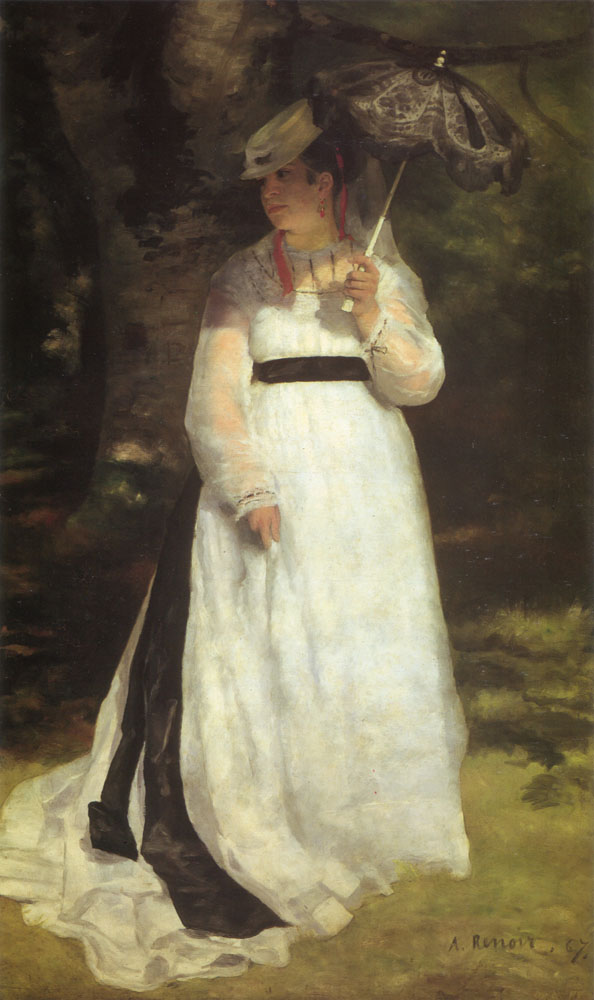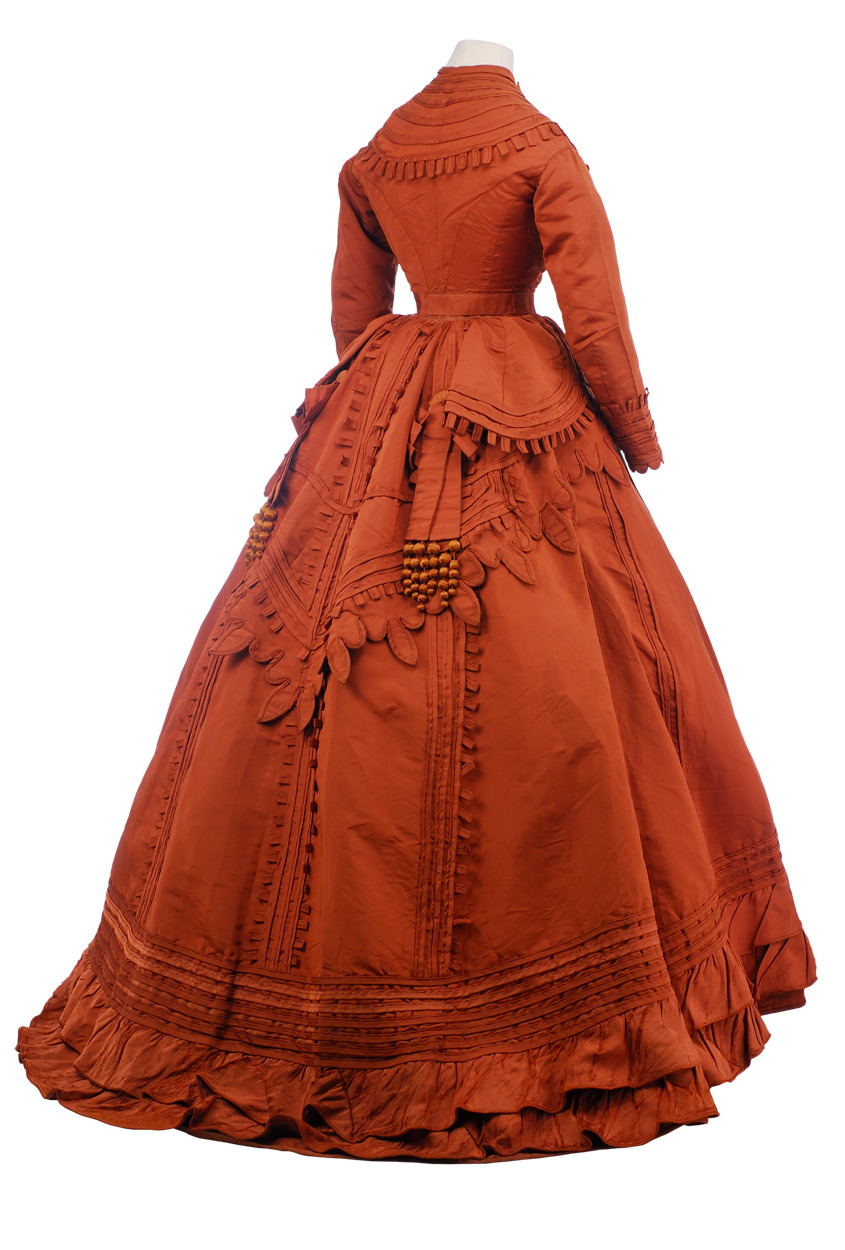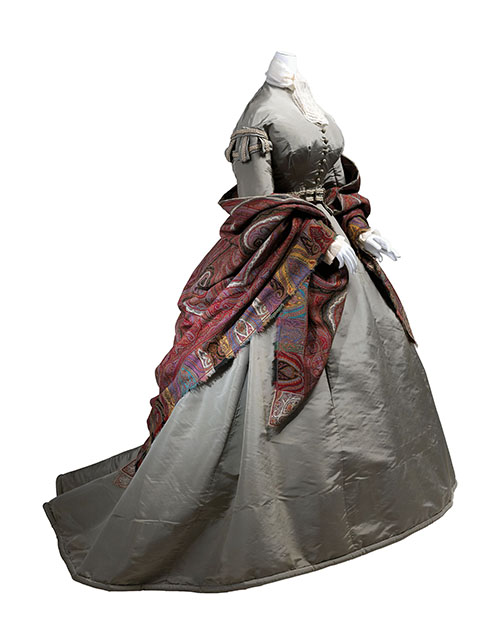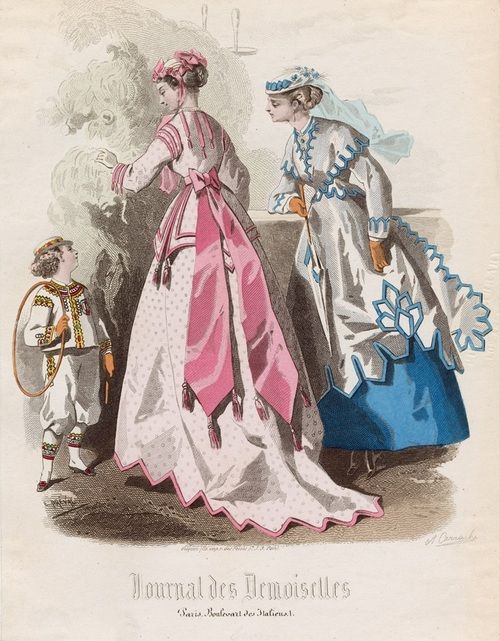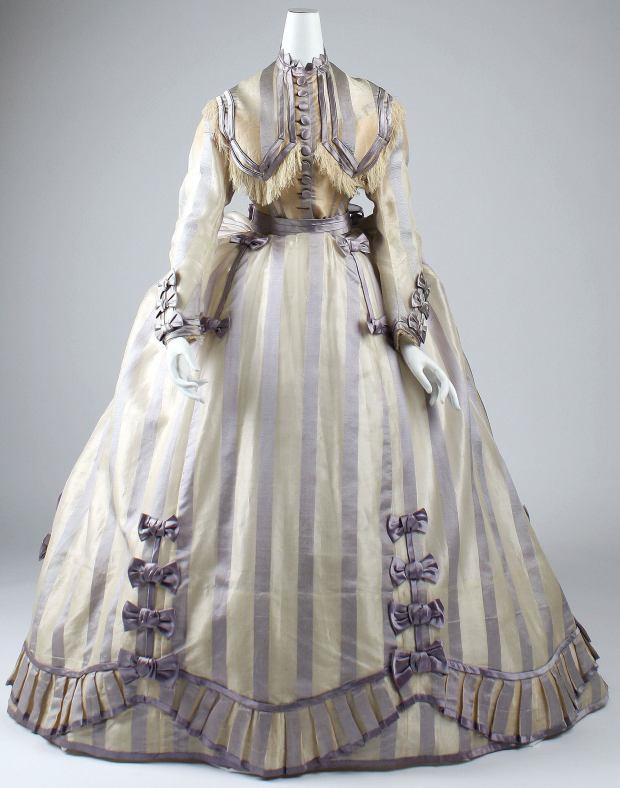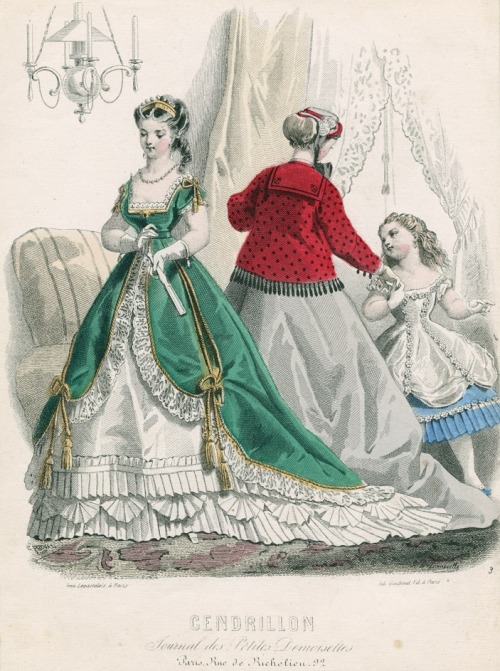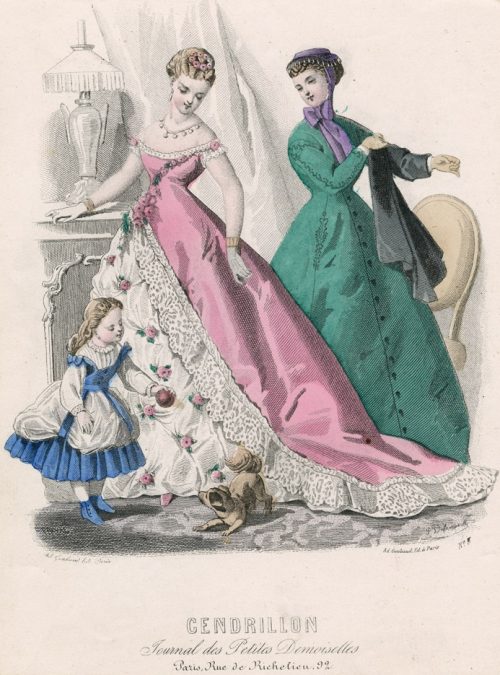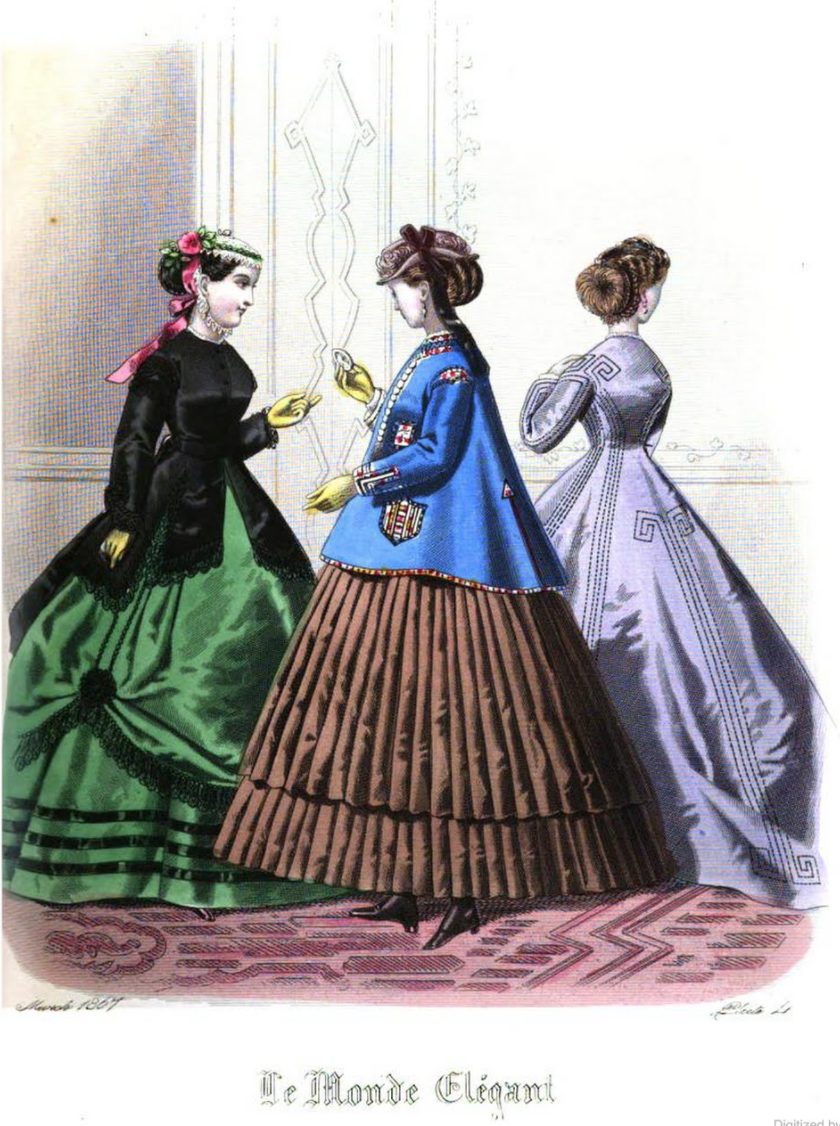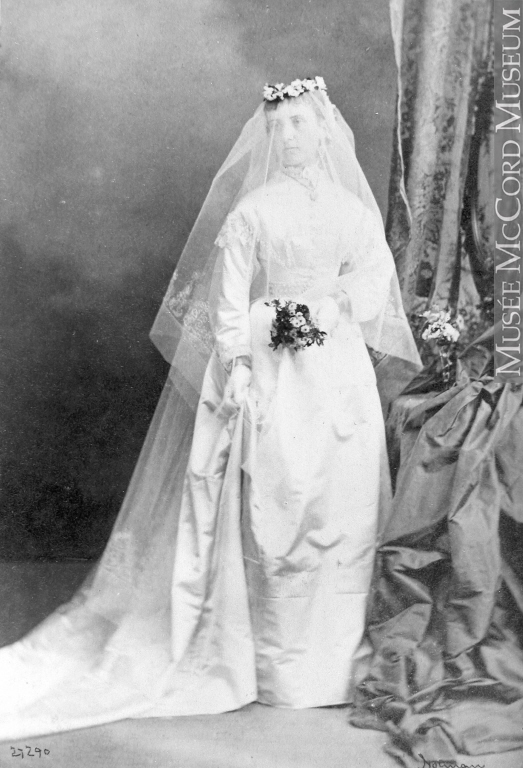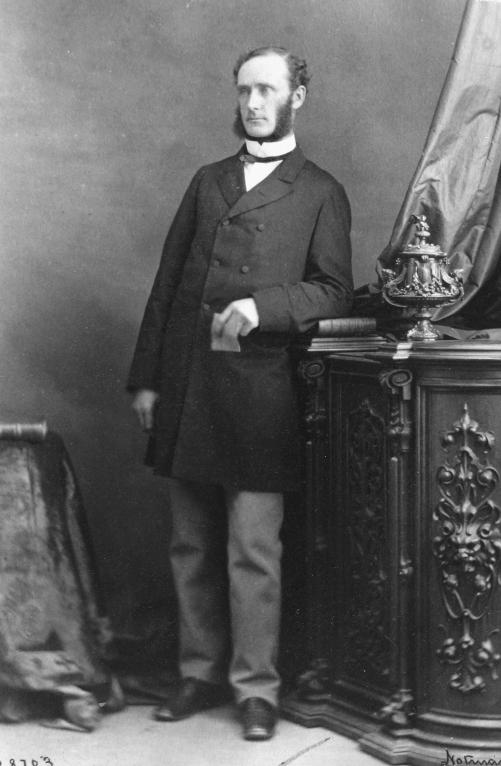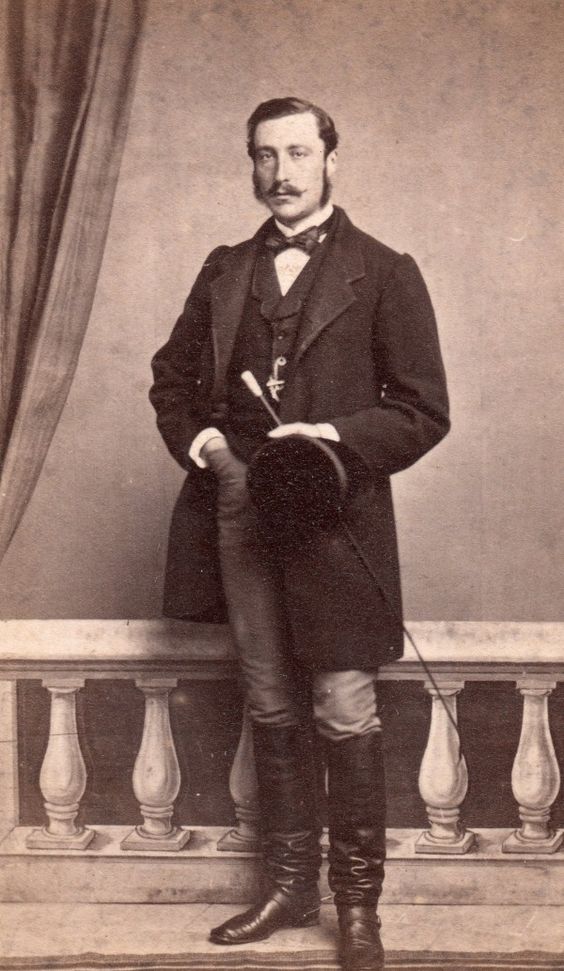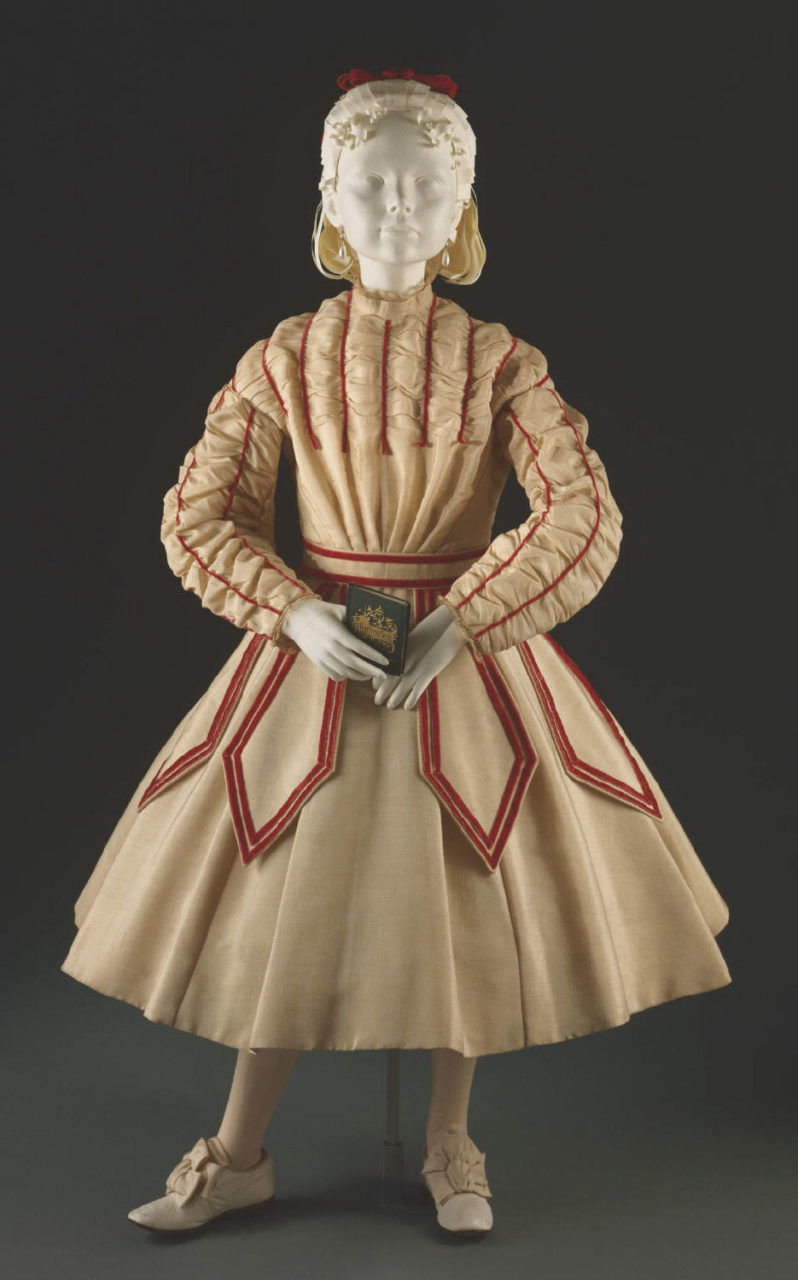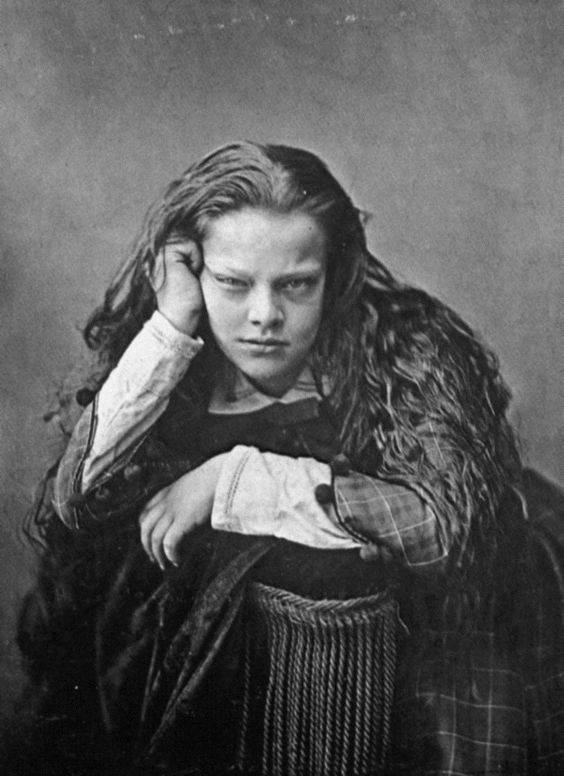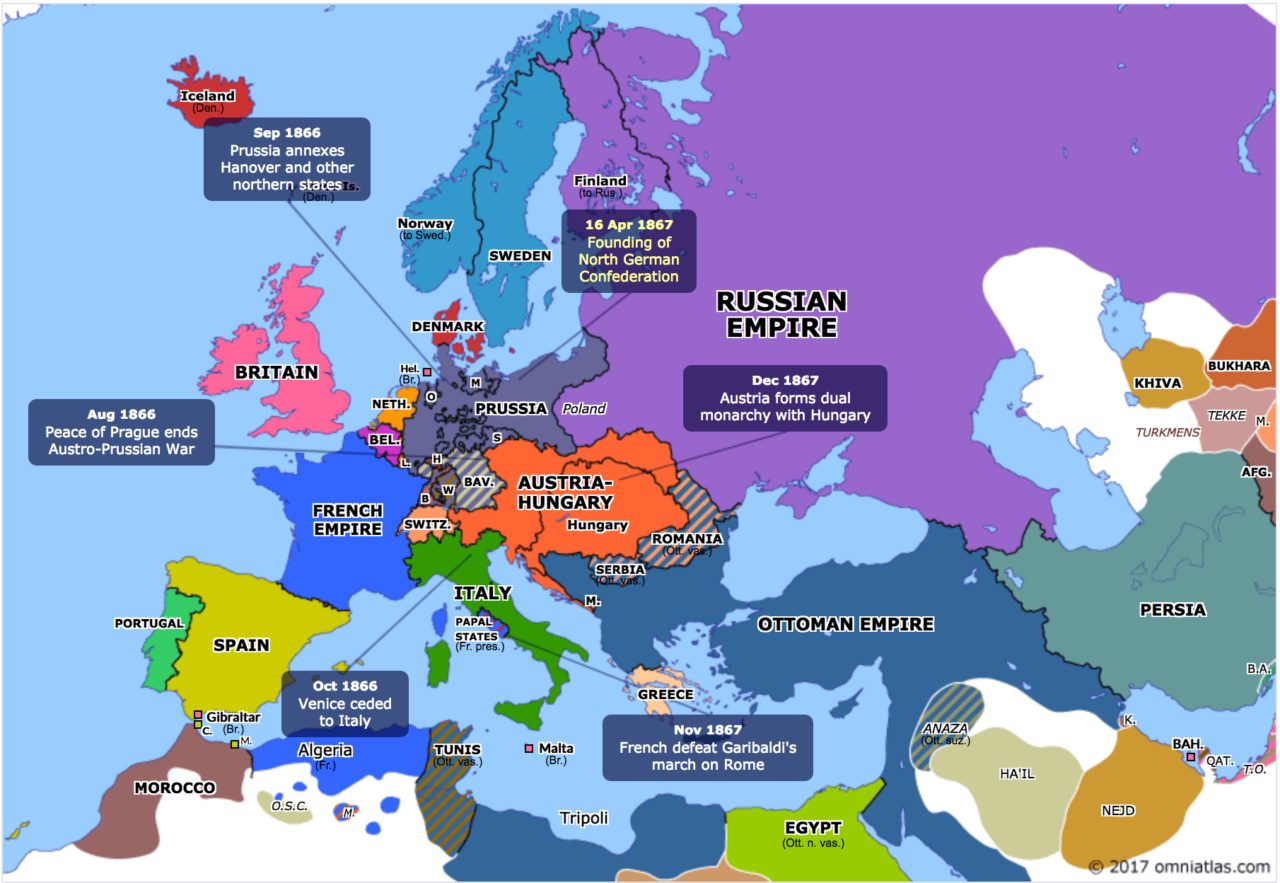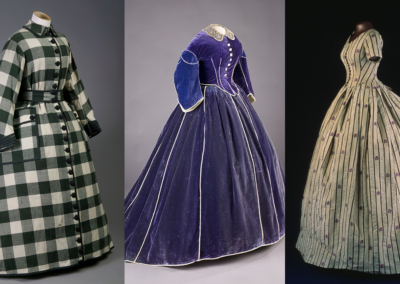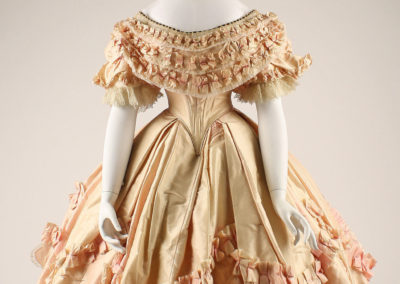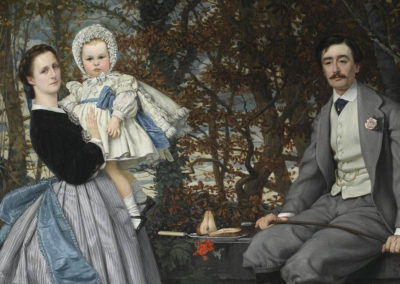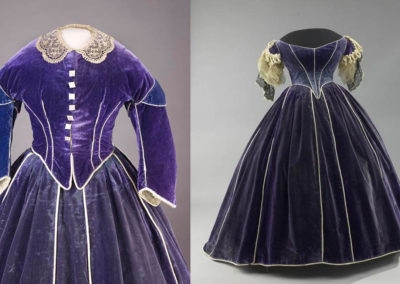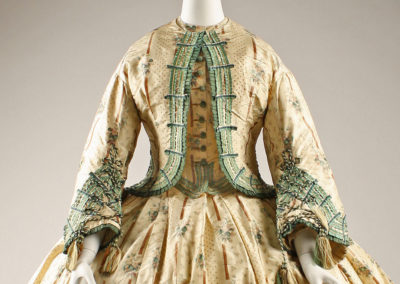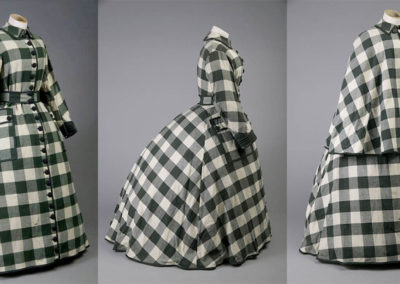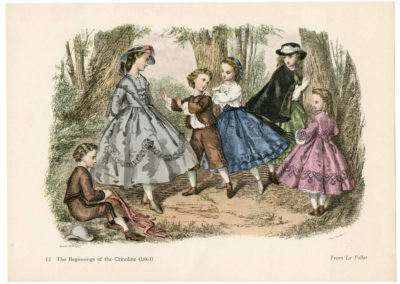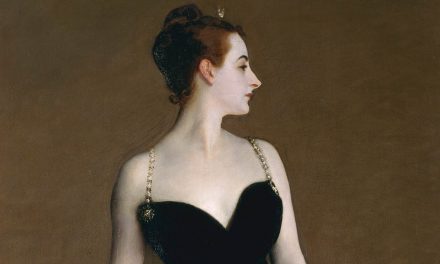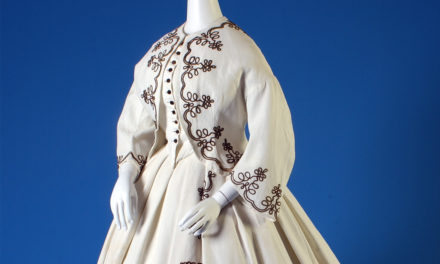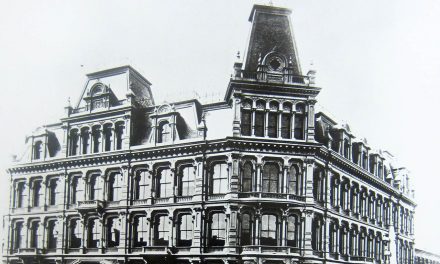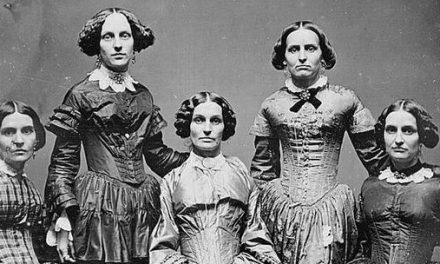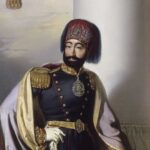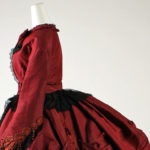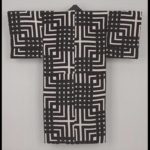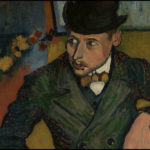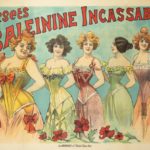OVERVIEW
1867 saw an increasing popularity of princess-cut dresses (those without a waist seam) as well as a greater emphasis on back volume as the crinoline begins to disappear. Men’s trousers began to be more narrowly cut in the “French style.”
Womenswear
One of the fashion highlights of the year 1867 was the Exposition Universelle in Paris where the Maison Gagelin exhibited ready-to-wear dresses on mannequins. One dress showcased at the exposition was a princesse style, or “Eugenie,” a dress made out of silk, brocade, and lace (Tétart-Vittu 275).
Fittingly, the princesse style and silk, especially white silk, were popular styles during the year of 1867. The January 1867 World of Fashion stated that the most fashionable dresses are cut ” à la princesse” (1). Throughout the year, the princesse style continued to be adopted widely. The body and skirt of the dress are cut together and as a result, have no seams(Figs. 8, 9, also childrenswear Fig. 1). The style is often plain in the front and less full in the back. Moreover, double skirts are also popular (Figs. 5, 6, 9). They are embellished in various ways with trims and cuts. In terms of trimmings in evening gowns, flowers are sparingly used and increasingly replaced with bows throughout the year.
Fig. 1 - Pierre-Auguste Renoir (French, 1841-1919). Lise with Umbrella, 1867. Oil on canvas; 184 × 115 cm (72.4 × 45.3 in). Essen: Museum Folkwang. Source: Wikimedia Commons
Fig. 2 - Alfred Stevens (Belgian, 1823-1906). The Parisian Sphinx, 1867. Oil on canvas; 72 x 53 cm. Antwerp: Royal Museum of Fine Arts Antwerp, 1373. Source: Koninklijk Museum Voor Schone Kunsten Antwerpen
Fig. 3 - Charles Fredrick Worth (English, 1825-1895). Day dress, 1867- 70. Vitacura: Museo de la Moda. Source: Pinterest
Fig. 4 - Designer unknown (French). Day dress, 1865-67. Gray silk faille. New York: The Metropolitan Museum of Art, C.I.58.4.4a-e. Gift of Mrs. Alfred Poor, 1958. Source: The Metropolitan Museum of Art
Fig. 5 - Artist unknown (French). Journal des Demoiselles, July 1867. Source: Pinterest
In December 1867, The World of Fashion reports that for evening dresses, broad sashes of lace and ribbon start from the front of the waist and form a large bow on the back. White silk is stated to be “one of the fashionable materials, and so is white muslin over white silk” (1). Figure 2 shows Alfred Stevens, The Parisian Sphinx, featuring a mysterious demimondaine wearing white translucent fabric, possibly chiffon dotted with flowers. She accessorizes with a black lace shawl and fur stole around her neck.
Additionally, the tight fitting paletot or peplum paletot made out of black silk and worn with a ceinture (waistbelt) is one of the fashionable garments for outdoor wear as observed in March 1867 from World of Fashion (see figure on the left in Fig. 9). It might be the only important garment for outdoor wear and are generally very short and are either very loose or fitted and square (1) (Fig. 9).
Fig. 6 - Depret (French). Dress, 1867-69. Piña cloth, silk. New York: The Metropolitan Museum of Art, C.I.62.35.7a–c. Gift of Miss Elizabeth R. Hooker, 1962. Source: The Metropolitan Museum of Art
Fig. 7 - Artist unknown (French). Cendrillon, January 1867. Source: Tumblr
Fig. 8 - Artist unknown (French). Cendrillon, Journal de petite Demosilles, March 1867. Source: Pinterest
Fig. 9 - Artist unknown (French). World of Fashion, vol. 44, no. 518 (March 1867). Source: Google Books
Fig. 10 - William Notman (Canadian, 1826-1891). Mrs. McDougall in wedding dress, Montreal, QC, 1867, 1867. Silver salts on paper mounted on paper - albumen process; 8.5 x 5.6 cm. Montreal: McCord Museum, I-27291.1. Purchase from Associated Screen News Ltd.. Source: McCord Museum
Menswear
The West End Gazette in their April 1867 issue noted that the English-style trouser was slowly disappearing and increasingly replaced with the French-style which was a tighter silhouette rather than a laid-back, comfortable fit that produced an “appearance of increased muscular development, and so add to the grace and harmony of the figure” (15). As noticed in figures 1, 2 and 4, the coat silhouette is slimmer and straight. The West End Gazette also reported the most popular color of the dress which was plain brown in various shades. Shades of bronze and green were introduced but were not adopted by most gentlemen (15). Figure 3 shows Frédéric Bazille wearing a coat with the color mixture of both bronze and green. However, Renoir’s choice of lighting could also distort the original colors of the suit.
Henri Fantin-Latour’s portrait of Manet was exhibited at the Paris Salon of 1867 (Fig. 1). Interestingly, Manet himself was not a part of the Salon that year, but his portrait was. Manet is portrayed by Fantin-Latour as a sophisticated, well-dressed gentleman, which was very different from his reputation as a “bohemian” (Art Institute). Manet is seen wearing a fitted sack coat and vest and high-waisted trousers. The blue tie, the only bright color in the clothes, helps bring out his eyes. Fantin-Latour helped increase Manet’s popularity in a clever way by showing the dapper bourgeois side to Manet.
Fig. 1 - Henri Fantin-Latour (French, 1836-1904). Édouard Manet, 1867. Oil on canvas; 117.5 x 90 cm (46 1/4 x 35 7/16 in). Chicago: The Art Institute of Chicago, 1905.207. Stickney Fund. Source: The Art Institute of Chicago
Fig. 2 - William Notman (Scottish-Canadian, 1826-1891). Dr. William H. Hingston, Montreal, QC, 1867, 1867. Silver salts on paper mounted on paper - albumen process; 8.5 x 5.6 cm. Montreal: Musée McCord, I-28703.1. Purchase from Associated Screen News Ltd.. Source: Musée McCord
Fig. 3 - Pierre-Auguste Renoir (French, 1841-1919). Frédéric Bazille, 1867. Oil on canvas; 105 x 73.5 cm. Paris: Musée d'Orsay. Bequest of Marc Bazille, 1924. Source: Musée d'Orsay
Fig. 4 - Artist unknown. Portrait d'homme à la canne, Men's fashion in Perpignan: French industry, 1867. Private Collection. Source: Institut du Grenat
CHILDREN’S WEAR
Fig. 1 - Artist unknown. Journal des Demoiselles, January 1867. Antwerp: ModeMuseum Provincie Antwerpen. Source: Europeana
Fig. 2 - Artist unknown. Les Modes Parisiennes, January 1867. Los Angeles: Los Angeles Public Library. Source: Pinterest
Fig. 3 - Maker unknown (American). Girl's dress, ca. 1867-1868. Ivory cotton/wool plain weave, red silk/cotton velvet ribbon, cotton lace; 77.5 x 55.9 cm (30.5 x 22 in). Philadelphia: Philadelphia Museum of Art, 1952-23-1. Gift of Mr. and Mrs. Bertram Lippincott, 1952. Source: Philadelphia Museum of Art
Fig. 4 - Julia Margaret Cameron (British, 1815-1879). Untitled, 1867. Photograph. Source: Pinterest
References:
- “Édouard Manet | The Art Institute of Chicago.” Accessed February 18, 2017. http://www.artic.edu/aic/collections/artwork/87467.
- “Observations on Fashions,” The West-End Gazette of Gentlemen’s Fashion 5, no. 58 (April 1867): 15. – Link
- “Observations on London and Parisian Fashions,” The World of Fashion 44, no. 517 (January 1867): 1. – Link
- “Observations on London and Parisian Fashions,” The World of Fashion 44, no. 521 (May 1867): 1. – Link
- “Observations on London and Parisian Fashions,” The World of Fashion 44, no. 528 (December 1867): 1. – Link
- Tétart-Vittu, Françoise, and Gloria Groom. “Key Dates in Fashion and Commerce, 1851-89.” In Impressionism, Fashion, & Modernity, ed. Gloria Groom, 275. New Haven: Yale University Press, 2012.
Historical Context
Wikipedia: 1867
Rulers:
- America:
- President Andrew Johnson (1865-69)
- England: Queen Victoria (1837-1901)
- France
- Emperor Napoleon III (1852-70)
- Spain
- Queen Isabel II (1833-68)
Europe 1867. Source: Omniatlas
Events:
- January 11 – Benito Juárez becomes Mexican president again.
- February 15 – First performance of Johann Strauss II‘s waltz “The Blue Danube” (An der schönen blauen Donau) at a concert of the Vienna Men’s Choral Association. Strauss adapts it into its popular purely orchestral version for the International Exposition in Paris later this year.
- February 17 – The first ship passes through the Suez Canal.
- September 14 – The first volume of Das Kapital(later translated into English as Capital) is published by Karl Marx.
- Pierre Michaux invents the front wheel-driven velocipede, the first mass-produced bicycle.
- South African diamond fields are discovered.
- Elias Howe’s sewing machine wins a gold medal at the 1867 Exposition Universelle. (Tétart-Vittu 275)
Primary/Period Sources
Resources for Fashion History Research
To discover primary/period sources, explore the categories below.
Have a primary source to suggest? Or a newly digitized periodical/book to announce? Contact us!
Fashion Plate Collections (Digitized)
- Costume Institute Fashion Plate collection
- Casey Fashion Plates (LA Public Library) - search for the year that interests you
- New York Public Library:
NYC-Area Special Collections of Fashion Periodicals/Plates
- FIT Special Collections (to make an appointment, click here)
- Englishwoman's Domestic Magazine (London: 1852-79), 1860-64, 1867-69 (TT500 .E6)
- Costume Institute/Watson Library @ the Met (register here)
- New York Public Library
- Brooklyn Museum Library (email for access)
Womenswear Periodicals (Digitized)
Etiquette Books (Digitized)
Menswear Periodicals / Etiquette Books (Digitized)
Secondary Sources
Also see the 19th-century overview page for more research sources... or browse our Zotero library.

